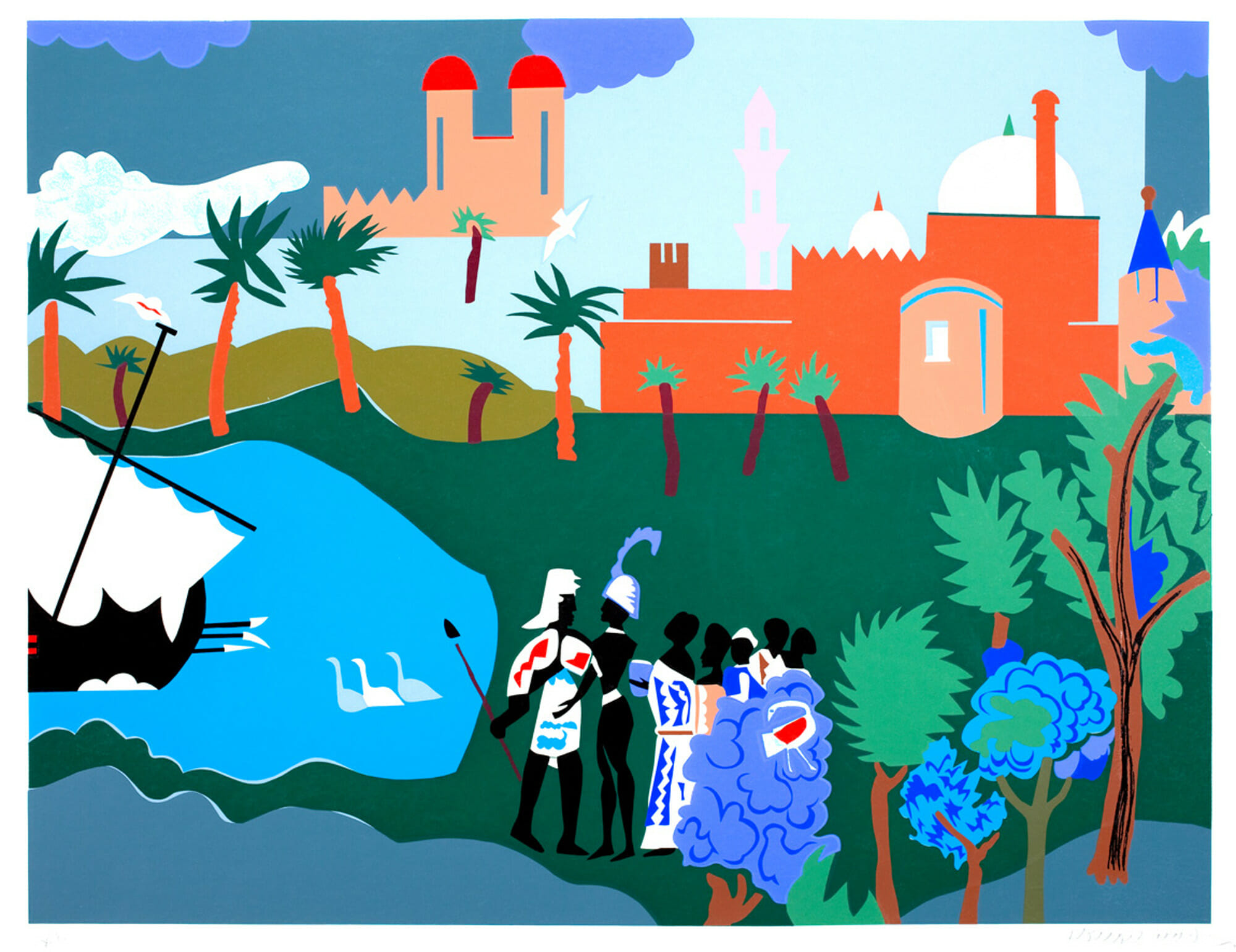
Romare Bearden – Odysseus Leaves Nausicaa
Odysseus Leaves Nausicaa
The Greek epic The Odyssey is filled with colorful tales of overcoming obstacles in the pursuit of an overriding goal. In the segment of the story shown here, Odysseus [oh dis see uhs] (also called Ulysses in Roman mythology) is saying goodbye to Nausicaa [now si kee ah], daughter of King Alcinoos [al si no uhs], who has rescued Odysseus and helped him obtain aid from her father to make his way back to his homeland. Odysseus is leaving Nausicaa’s beautiful land of Phaiacia [fī ay se a] to sail in the king’s ship to Ithaca. Standing next to Nausicaa and helping to see him off are members of her court in their royal attire. The ship is ready, with its billowing white sail and its flag flying. Palm trees and birds convey the tropical setting of the tale. Bearden has used large expanses of exuberant colors, as well as curving, jagged, lively diagonal lines and cropped shapes to describe three-dimensional space as well as communicate the emotions of departure—sorrow and anticipation.
Romare Bearden first made ink drawings of the Greek adventurer who fought in battles against the city of Troy after his own service as an infantryman in World War II. In the 1970s, late in his life and career, and long after he had studied ancient myths at the Sorbonne in Paris, Bearden returned to The Odyssey as a subject in several formats, including collage, watercolor, and screenprints. By this time he had been long known for his deft and jazz-inspired improvisations with collage, which he called “the transmutation of sound into colors.” Trains, crowded urban streets, the migration of black workers to the northern cities, and scenes from the rural South of his childhood had been the subjects of his singular style. Now, using his jazzlike sense of rhythm and color, as well as inspiration from Henri Matisse’s vibrantly colored, silhouetted cut-outs in his own late-in-life Jazz series, Bearden interpreted Odysseus as an African hero, emphasizing the universality of themes in the Homeric narratives. His Odysseus series contains echoes of the Italian painter Bernardino Pintoricchio’s early sixteenth-century painting of Odysseus’ return home after the Trojan War. However, Bearden set his story in the West African country of Benin, enabling identification with the images by African American viewers, with their own stories of exile and longing for home. Bearden believed that art could express universal human feelings and experience that would resonate with people of varied backgrounds. “I give every effort to give my works a universal character, and I feel that the meanings can be extended and reinforced by means of myth and ritual.”
This screenprint, printed from five screens, ingeniously reproduces the colors and forms of the original collage of the same scene, which was made of a variety of papers with foil, paint, and graphite applied to fiberboard. Bearden said of his Odysseus series, “It is universal. So if a child in Benin or in Louisiana…sees my paintings of Odysseus, he can understand the myth better.”
The Artist

Romare Bearden
Born in Charlotte, North Carolina, Romare Bearden moved with his family to Harlem as a young child, part of the Great Migration of African Americans from the South to opportunities in the North. Bearden’s father worked on the railroad and was an amateur pianist. His mother was a political activist and editor of the Chicago Defender. When the family moved to New York their apartment became a meeting place of artists and intellectuals. Both his parents were an integral part of the Harlem Renaissance. Bearden spent summers in North Carolina with his grandparents. During high school he lived in Pittsburgh, where his maternal grandmother ran a boarding house for the workers who had come to the North looking for employment.
In the 1960’s Bearden was an active participant in the Civil Rights movement and a founder of the art collective, Spiral. The small black and white collages he made during that period became the bases for his later work. These collages, created in 1964, combined Cubist composition with a sure knowledge of African sculpture. He used flat, overlapping planes of color in a shallow space where shapes would merge and come apart, tilt and spin. He made faces into masks that evoked powerful emotions, and he changed the proportions of heads and hands in relationship to their importance, in the same way traditional West African sculpture manipulated the body for expressive purposes. Artist Stuart Davis had urged Bearden to consider jazz—a musical form Bearden loved—as a source of inspiration. Davis’s suggestion led Bearden to incorporate the improvisation and rhythmic complexity of jazz into his art. Bearden said, “Jazz has shown me the ways of achieving artistic structures that are personal to me; but it also provides me continuing finger-snapping, head-shaking enjoyment of this unique, wonderful music.”
In 1977 Bearden created a series of twenty collages, Black Odyssey, based on episodes from Homer’s Odyssey that bridged classical mythology and African American culture. He also made watercolor versions of the same images around the same time. About two years later he translated six of the compositions into screenprints, which were published in 1979 as the Odysseus Suite. These images, including Odysseus Leaves Nausicaa, demonstrate Bearden’s ongoing artistic theme of the seeker of a welcoming home.
Key Ideas
Discussion Questions
- Romare Bearden has combined flat shapes of color to create the illusion of three-dimensional space. What do you notice about choices of color, shape, and line that seem to create this effect?
- How do the colors and the shapes work together to suggest a beat or rhythm in this image? What sounds can you imagine as part of this picture?
- How might you tell a story of ambivalence about saying goodbye and anticipating departure based on this image? Who might be some characters? What would be your setting?

